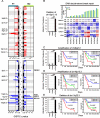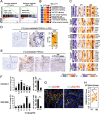Integrated genomic and transcriptomic analysis reveals unique characteristics of hepatic metastases and pro-metastatic role of complement C1q in pancreatic ductal adenocarcinoma
- PMID: 33397441
- PMCID: PMC7780398
- DOI: 10.1186/s13059-020-02222-w
Integrated genomic and transcriptomic analysis reveals unique characteristics of hepatic metastases and pro-metastatic role of complement C1q in pancreatic ductal adenocarcinoma
Abstract
Background: Pancreatic ductal adenocarcinoma (PDAC) is one of the most lethal cancers due to its high metastasis rate in the liver. However, little is known about the molecular features of hepatic metastases due to difficulty in obtaining fresh tissues and low tumor cellularity.
Results: We conduct exome sequencing and RNA sequencing for synchronous surgically resected primary tumors and the paired hepatic metastases from 17 hepatic oligometastatic pancreatic ductal adenocarcinoma and validate our findings in specimens from 35 of such cases. The comprehensive analysis of somatic mutations, copy number alterations, and gene expressions show high similarity between primary tumors and hepatic metastases. However, hepatic metastases also show unique characteristics, such as a higher degree of 3p21.1 loss, stronger abilities of proliferation, downregulation of epithelial to mesenchymal transition activity, and metabolic rewiring. More interesting, altered tumor microenvironments are observed in hepatic metastases, especially a higher proportion of tumor infiltrating M2 macrophage and upregulation of complement cascade. Further experiments demonstrate that expression of C1q increases in primary tumors and hepatic metastases, C1q is mainly produced by M2 macrophage, and C1q promotes migration and invasion of PDAC cells.
Conclusion: Taken together, we find potential factors that contribute to different stages of PDAC metastasis. Our study broadens the understanding of molecular mechanisms driving PDAC metastasis.
Keywords: C1q; Genomics; Hepatic metastasis; Pancreatic ductal adenocarcinoma; Transcriptomics; Tumor microenvironment.
Conflict of interest statement
The authors declare that they have no competing interests.
Figures






Similar articles
-
Single-cell transcriptome analysis reveals subtype-specific clonal evolution and microenvironmental changes in liver metastasis of pancreatic adenocarcinoma and their clinical implications.Mol Cancer. 2024 May 3;23(1):87. doi: 10.1186/s12943-024-02003-0. Mol Cancer. 2024. PMID: 38702773 Free PMC article.
-
Single-nucleus RNA sequencing and spatial transcriptomics reveal an immunosuppressive tumor microenvironment related to metastatic dissemination during pancreatic cancer liver metastasis.Theranostics. 2025 Apr 13;15(11):5337-5357. doi: 10.7150/thno.108925. eCollection 2025. Theranostics. 2025. PMID: 40303346 Free PMC article.
-
Stabilized epithelial phenotype of cancer cells in primary tumors leads to increased colonization of liver metastasis in pancreatic cancer.Cell Rep. 2021 Apr 13;35(2):108990. doi: 10.1016/j.celrep.2021.108990. Cell Rep. 2021. PMID: 33852841 Free PMC article.
-
The role of epithelial-mesenchymal transition and autophagy in pancreatic ductal adenocarcinoma invasion.Cell Death Dis. 2023 Aug 7;14(8):506. doi: 10.1038/s41419-023-06032-3. Cell Death Dis. 2023. PMID: 37550301 Free PMC article. Review.
-
Single-cell profiling to explore pancreatic cancer heterogeneity, plasticity and response to therapy.Nat Cancer. 2023 Apr;4(4):454-467. doi: 10.1038/s43018-023-00526-x. Epub 2023 Mar 23. Nat Cancer. 2023. PMID: 36959420 Free PMC article. Review.
Cited by
-
Tumor immune microenvironment-based therapies in pancreatic ductal adenocarcinoma: time to update the concept.J Exp Clin Cancer Res. 2024 Jan 2;43(1):8. doi: 10.1186/s13046-023-02935-3. J Exp Clin Cancer Res. 2024. PMID: 38167055 Free PMC article. Review.
-
Complement C1QC as a potential prognostic marker and therapeutic target in colon carcinoma based on single-cell RNA sequencing and immunohistochemical analysis.Bosn J Basic Med Sci. 2022 Oct 23;22(6):912-922. doi: 10.17305/bjbms.2022.7309. Bosn J Basic Med Sci. 2022. PMID: 35765947 Free PMC article.
-
C1q+ tumor-associated macrophages contribute to immunosuppression through fatty acid metabolic reprogramming in malignant pleural effusion.J Immunother Cancer. 2023 Aug;11(8):e007441. doi: 10.1136/jitc-2023-007441. J Immunother Cancer. 2023. PMID: 37604643 Free PMC article.
-
C1q+ Macrophage-Tumor Cell Interaction Promoted Tumorigenesis via GPR17/PI3K/AKT Pathway Induced DNA Hypermethylation in Nasopharyngeal Carcinoma.Adv Sci (Weinh). 2025 Jul;12(26):e2503434. doi: 10.1002/advs.202503434. Epub 2025 Apr 2. Adv Sci (Weinh). 2025. PMID: 40171991 Free PMC article.
-
The lncRNA LINC01605 promotes the progression of pancreatic ductal adenocarcinoma by activating the mTOR signaling pathway.Cancer Cell Int. 2024 Jul 24;24(1):262. doi: 10.1186/s12935-024-03440-z. Cancer Cell Int. 2024. PMID: 39048994 Free PMC article.
References
-
- Yachida S, Iacobuzio-Donahue CA. The pathology and genetics of metastatic pancreatic cancer. Arch Pathol Lab Med. 2009;133:413–422. - PubMed
Publication types
MeSH terms
Substances
LinkOut - more resources
Full Text Sources
Other Literature Sources
Medical
Molecular Biology Databases

